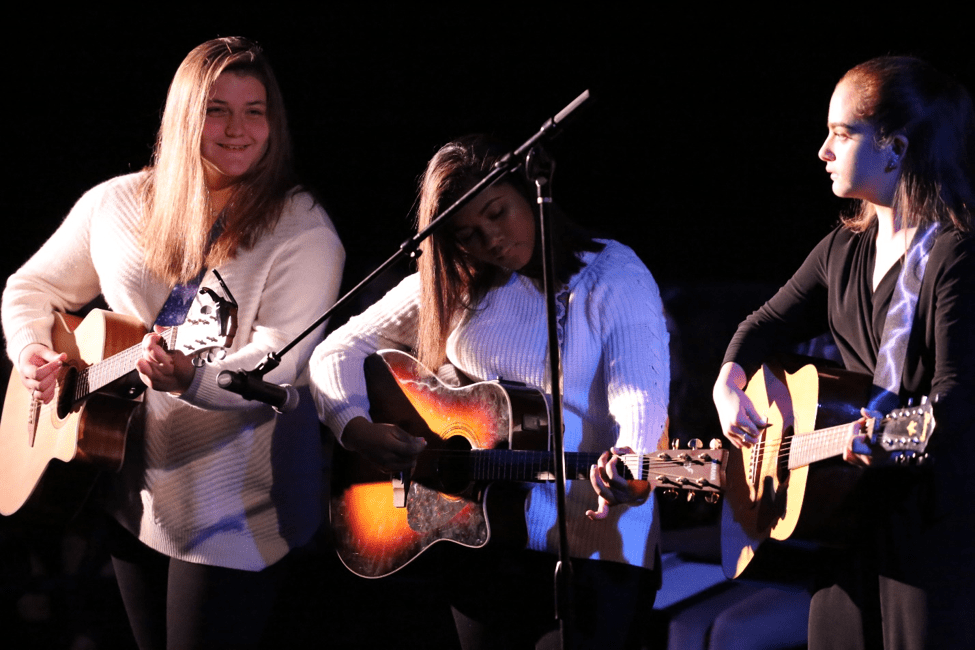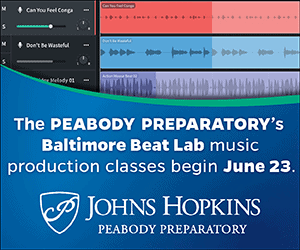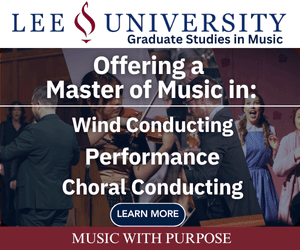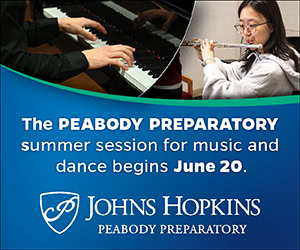/ News Posts / Guitar Class in the Constitution State
Guitar Class in the Constitution State
Number 43: The State of Connecticut
By Thomas Amoriello Jr.
NAfME Council for Guitar Education Chair
In this edition of “50 States of Guitar Class,” the NAfME Council for Guitar Education visits Danbury, Connecticut, and the guitar program at Immaculate High School which is directed by Niall Reynolds. Mr. Reynolds looks forward to working with students each day who find joy and passion in music. He hopes he can use all his experiences to help his students progress and grow as musicians.
In the Roman Catholic tradition, Immaculate High School fosters the development of the whole student by nurturing individual spiritual, moral, intellectual, physical, and social growth through an academically rigorous college prepatory curriculum that encourages respect, responsibility, reverence, creativity, and leadership. Immaculate High School, also ranked by Niche among the top ten best private college-prep high schools in Fairfield County, has the highest student SAT scores of the Diocese of Bridgeport schools. Last March, Immaculate High School was awarded $6,909 in grant money to create a music technology laboratory, to enhance its popular music education programs. Immaculate received the monies from a grant from Foundations in Education, a non-profit initiative that assists the Diocese of Bridgeport’s ongoing mission to support Catholic education in Fairfield County. From an issue of the Fairfield County Catholic publication,
“Niall Reynolds, Immaculate’s band director and music teacher, applied for and received the grant, which will allow the school to build a state-of-the-art Music Production Lab for the development of modern, cutting-edge music curriculum and coursework. The lab will consist of student workstations and new equipment such as iMac computers and professional software, keyboard controllers, microphones, headphones, mixers and speaker systems.
“‘The lab will emphasize the importance of creativity as an essential part of educating the whole student and help develop student confidence in their music abilities as well as creative potential. Student interest in music theory and writing and recording music has increased substantially, and this technologically modern lab will be a valuable tool for our young musicians,’ said Mr. Reynolds.
“Mr. Reynolds will also work with students to create portfolios in the lab for use in future career endeavors. ‘I want to change the prevailing attitude that music is mysterious, inaccessible, and obscure—the Music Production Lab can remove the barriers of fear and anxiety that sometimes accompany music education,’ Mr. Reynolds noted.”
The NAfME Council for Guitar Education would like to thank Mr. Reynolds for sharing his knowledge with the NAfME membership.
Please tell us about your school and overall music program.
Immaculate High School has a student body of about 500 students. It is located in the city of Danbury, Connecticut. A private Catholic high school, Immaculate accepts students grades 9 through 12 and draws from a handful of towns in Fairfield County. Athletics, arts, and community service are all very strong areas here.
Our music program consists of instrumental, choral, and general music classes taught by two teachers. I am responsible for the Guitar, Concert Band, and Music Technology classes, and we share Piano teaching. The chorus teacher not only teaches several choir classes but also assists in the spring musical and prepares worship music for monthly school Masses. Students at Immaculate are required to take an arts credit but many become passionate and stay involved in music for their entire high school careers. Although we have a robust performing season with our large ensembles, one of the features of our program that we are most proud of is our recording studio and music technology courses where students learn how to write and record music. The guitar program, however, is the largest it has ever been this year with two full class sections, beginning and advanced.
Please tell us about your own personal musical background growing up and your collegiate experience.
I began playing the clarinet around fourth grade, which was a bit early for my school district but the fantastic teachers there gave me lessons until fifth grade band began. Outside of school I took private lessons in clarinet early, but I found other instruments to be just as exciting. I began playing drumset in middle school. I was introduced to the guitar around this time, but I did not start playing it regularly until much later.
The best part was that my parents were both musicians and encouraged me to keep it going. Their support of music was priceless! It became the biggest part of my life in middle school and high school experience after I joined the school jazz band and marching band. I majored in music education at the University of Connecticut on the clarinet and began teaching after graduating. I still miss those UConn ensembles; they really were life-changing experiences. I somehow had the time and luck to participate in the Marching Band, Wind Ensemble, Orchestra, and even the Steel Pan Ensemble. I graduated in 2015, and I’ve been at Immaculate ever since.
How do the guitar family of instruments fit into your teaching?
I teach two classes that focus mainly on guitar instruction. Students play acoustic guitars and learn to play with a pick. In the past I tried to teach them “Smoke on the Water” on the first day of class, but I’ve learned to go a little slower. I later found out that that’s a scene in the School of Rock. I’m not quite Jack Black yet, but I’m learning!
What obstacles did you face when you were first hired at your school? Now?
The biggest obstacle was that I was not an experienced performing guitarist, and I had trained mostly in concert band techniques, score study, etc. I had to stumble around for a while. I learned to accept the fact that I can still play and teach the guitar well without having played onstage with B.B. King. The kids can figure things out even if my guitar skills are lacking in a particular area, although these days they aren’t so bad!
The biggest obstacle now that the class is established is teaching the appropriate historical context of songs. I wasn’t around for most of the big guitar moments of the 20th century, so I have to learn much of the history on my own. I highly recommend The Birth of Loud by Ian S. Port for those looking for an introduction to popular music and guitar history.
What kind of classes related to the guitar do you teach?
I teach a beginning level guitar class and an honors level. Students in these classes form bands and practice independently once they’ve mastered the basics. I often use Little Kids Rock material; that stuff is genius for popular guitar playing.
What would you like to say to the non-guitarist music educator who is about to or interested in incorporating the guitar into their program?
I would say, Start now. The sooner the better. It’s okay to not know anything at first. In fact, I’ve found the fastest way to learn something is to teach it to others. I start a lot of subjects/class units this way, and though I wish I was an expert already, it’s also fun learning something new and then teaching it that day!
“I think it was always there, but they finally got the opportunity to flourish because I believe in them. They learn to believe in themselves, and then there’s no stopping them.”
Do you have any success stories you would like to share about students (musical and non-musical)?
I’ve actually had a few amazing instances where a student who had never played before became a full-fledged guitarist in one year and performed onstage with confidence. This is my favorite thing to see, because they discovered their love of guitar in my class! I think it was always there, but they finally got the opportunity to flourish because I believe in them. They learn to believe in themselves, and then there’s no stopping them.
What do you tell your talented students who are planning to pursue music or guitar studies in high school or college after they finish with you?
Don’t quit! It’s more than a career or a job or a major. It’s a part of you, and you shouldn’t forget that. Lots of students go to college and say things like, “There’s no time to play anymore.” Don’t let your daily responsibilities get in the way of doing things you love the most. Handle them, of course, but leave time for the important stuff!
Do you have any networking or advocacy tools that have worked for you promoting your program that would help other educators?
I try to focus on two things, the first being the classroom experience. This is the main reason that kids will take your class—they are learning and having fun too. That’s it. When every day contains a great musical experience, kids will want to come back. The other thing is you need to tell students to join. I find that they don’t always want to take the leap at first. Tell students you want them in your class, and if it’s genuine, you’ll be surprised with how willingly they sign up. Then it’s your time to deliver the great classroom experience.
What kind of future do you see for guitar in music education in Connecticut schools?
I think guitar can be the best part of the day for certain kids. Although I can’t see the future, it is certainly becoming more popular here in Connecticut. Some kids are a great fit for concert band; some are a great fit for choir; some are guitarists. I don’t think these areas need to compete; I think they need to help each other.
What type of lesson plans have you done for your classes that may be unique?
I like doing a TAB of the week—this is a great warm-up and intro to the many famous electric guitar riffs out there. It’s not very sophisticated—just write a famous riff on the board using TAB notation and come back to it each day that week in the beginning of class. Some kids really look forward to this—“What’s the TAB of the Week going to be?!” I quiz them once a quarter on their three favorite TABs, played from memory. If this sounds daunting, I would start by just listening to rock radio/playlists until a few riffs get stuck in your head. This is where you can start.
Do you do any musical performances or activities outside of your private school teaching duties?
I play drums in a rock band on weekends, and I also play clarinet in a community band that meets during the week. I teach lessons on the weekend, and I really look forward to possible pit orchestra gigs in the summer! For some reason I love playing low reed books and sitting in the dark surrounded by giant saxophones and clarinets.
“You don’t need to be an actual rock star to make a kid feel like one.”
Any last thoughts to conclude our interview?
It’s an honor to be interviewed, especially since I never thought I would end up as a guitar teacher, but it’s been a blast! I recommend it to anyone who wants to help inspire the future guitar players of the world. You don’t need to be an actual rock star to make a kid feel like one.
Past “Guitar Class in 50 States” articles:
- Number 50: The Granite State (New Hampshire)
- Number 49: The Green Mountain State (Vermont)
- Number 48: The Mountain State (West Virginia)
- Number 47: The Hoosier State (Indiana)
- Number 46: The Mount Rushmore State (South Dakota)
- Number 45: The Pine Tree State (Maine)
- Number 44: The Badger State (Wisconsin)
- Number 42: The Evergreen State (Washington)
- Number 41: The Pelican State (Louisiana)
- Number 40: The Beaver State (Oregon)
- Number 39: The Equality State (Wyoming)
- Number 38: The Empire State (New York)
- Number 37: The Old Line State (Maryland)
- Number 36: The Centennial State (Colorado)
- Number 35: The Bay State (Massachusetts)
- Number 34: The Sooner State (Oklahoma)
- Number 33: The Prairie State (Illinois)
- Number 32: The Hawkeye State (Iowa)
- Number 31: The Volunteer State (Tennessee)
- Number 30: The Palmetto State (South Carolina)
- Number 29: The Natural State (Arkansas)
- Number 28: The Tar Heel State (North Carolina)
- Number 27: The Magnolia State (Mississippi)
- Number 26: The Peace Garden State (North Dakota)
- Number 25: The Treasure State (Montana)
- Number 24: The First State (Delaware)
- Number 23: The Buckeye State (Ohio)
- Number 22: The Yellowhammer State (Alabama)
- Number 21: The Sunflower State (Kansas)
- Number 20: The Great Lakes State (Michigan)
- Number 19: The Lone Star State (Texas)
- Number 18: The Bluegrass State (Kentucky)
- Number 17: The Golden State (California)
- Number 16: The Show-Me State (Missouri)
- Number 15: The Keystone State (Pennsylvania)
- Number 14: The Last Frontier State (Alaska)
- Number 13: The Beehive State (Utah)
- Number 12: The Peach State (Georgia)
- Number 11: The Cornhusker State (Nebraska)
- Number 10: The Gem State (Idaho)
- Number 9: The Old Dominion (Virginia)
- Number 8: The Aloha State (Hawaii)
- Number 7: The Land of Enchantment (New Mexico)
- Number 6: The Sunshine State (Florida)
- Number 5: The Grand Canyon State (Arizona)
- Number 4: The Ocean State (Rhode Island)
- Number 3: The North Star State (Minnesota)
- Number 2: The Silver State (Nevada)
- Number 1: The Garden State (New Jersey)
About the author:
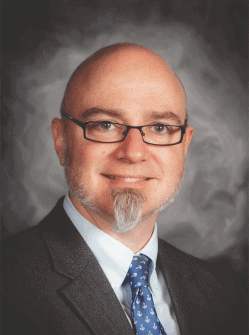 Thomas Amoriello Jr. serves as the chair on the NAfME Council for Guitar Education and is also the former Chairperson for the New Jersey Music Education Association. Tom has taught guitar classes for the Flemington Raritan School District in Flemington, New Jersey, since 2005 and was also an adjunct guitar instructor at Cumberland County College, New Jersey, for five years. He has earned a Master of Music Degree in Classical Guitar Performance from Shenandoah Conservatory and a Bachelor of Arts in Music from Rowan University. He is the author of the children’s picture books A Journey to Guitarland with Maestro Armadillo and Ukulele Sam Strums in the Sand, both available from Black Rose Writing. He recently made a heavy metal recording with a stellar roster of musicians including former members of Black Sabbath, Whitesnake, Ozzy Osbourne, Yngwie J. Malmsteen’s Rising Force, and Dio that was released on H42 Records of Hamburg, Germany. The record released on 12-inch vinyl and digital platforms has received favorable reviews in many European rock magazines and appeared on the 2018 Top 15 Metal Albums list by Los Angeles KNAC Radio (Contributor Dr. Metal). Visit thomasamoriello.com for more information.
Thomas Amoriello Jr. serves as the chair on the NAfME Council for Guitar Education and is also the former Chairperson for the New Jersey Music Education Association. Tom has taught guitar classes for the Flemington Raritan School District in Flemington, New Jersey, since 2005 and was also an adjunct guitar instructor at Cumberland County College, New Jersey, for five years. He has earned a Master of Music Degree in Classical Guitar Performance from Shenandoah Conservatory and a Bachelor of Arts in Music from Rowan University. He is the author of the children’s picture books A Journey to Guitarland with Maestro Armadillo and Ukulele Sam Strums in the Sand, both available from Black Rose Writing. He recently made a heavy metal recording with a stellar roster of musicians including former members of Black Sabbath, Whitesnake, Ozzy Osbourne, Yngwie J. Malmsteen’s Rising Force, and Dio that was released on H42 Records of Hamburg, Germany. The record released on 12-inch vinyl and digital platforms has received favorable reviews in many European rock magazines and appeared on the 2018 Top 15 Metal Albums list by Los Angeles KNAC Radio (Contributor Dr. Metal). Visit thomasamoriello.com for more information.
Did this blog spur new ideas for your music program? Share them on Amplify! Interested in reprinting this article? Please review the reprint guidelines.
The National Association for Music Education (NAfME) provides a number of forums for the sharing of information and opinion, including blogs and postings on our website, articles and columns in our magazines and journals, and postings to our Amplify member portal. Unless specifically noted, the views expressed in these media do not necessarily represent the policy or views of the Association, its officers, or its employees.
Catherina Hurlburt, Marketing Communications Manager. February 20, 2020. © National Association for Music Education (NAfME.org)
Published Date
February 20, 2020
Category
- Ensembles
Copyright
February 20, 2020. © National Association for Music Education (NAfME.org)
